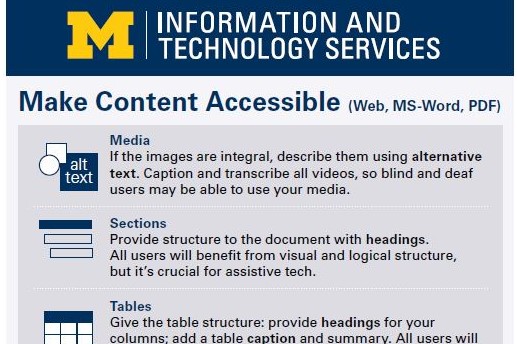Accessibility efforts are only successful at large institutions and organizations if the efforts being made are scalable; what this means in context is each individual must take ownership in their portion of responsibility to accomplish these goals. In an effort to educate about high-incidence accessibility issues and spread awareness of accessibility efforts, ITS has come up with Accessibility Quick Tips. (Physical copies can also be made available for distribution.) This resource lists six tips for avoiding common pitfalls associated with digital accessibility. While this handy and helpful information will not create a perfectly accessible digital space, it will get you well on your way toward that goal.
The approach toward making digital spaces accessible is never “one size fits all”—different disabilities will require different considerations. Similarly, the role in which you operate will require a different approach to accessibility as well. For example, developers, content producers, and project managers all have a responsibility to make sure accessibility is considered and implemented fundamentally within their processes. However, this takes shape differently depending on your position.
- For developers, your primary concern is usually the markup or code, so making sure you’re current on best practices for building technologies in an accessible fashion is imperative. Considerations like: building for mobile first, using frameworks that prioritize responsive design, properly applying ARIA (Accessibility Rich Internet Applications) attributes to SPA’s (Single Page Applications). All of these things and more are crucial for taking ownership in your role to aid in university accessibility efforts.
- For content producers, accessibility considerations are a bit different. Assuming the developers on your project create an accessible shell of a website for you to drop content into, it can still be made “unusable” by a content producer and thus inaccessible. Things to keep in mind are readability, font choices, color contrast, and tables. Content with unnecessary amounts of jargon, busy font faces, poor color contrast, and tables without proper labels and titles will make a digital space unpleasant and potentially unusable for all users, especially those with disabilities.
- Project managers have a more nuanced role in accessibility efforts as individuals who usually see the entire life cycle of a project, from discussions to development and ending with the rollout. Ensuring that accessibility is discussed at every juncture of the project is key. Leaving accessibility considerations for QA testing, or the end of the project is always a problematic and clunky process. Doing something as simple as adding accessibility to your project checklists and communicating with accessibility analysts ahead of time will keep accessibility in everyone’s mind and prevent roadblocks during rollout.
If you would like to learn more about how you can take some ownership of accessibility within your role, then please reach out to us! Everyone has an important part to play in making our university more accessible for all!

